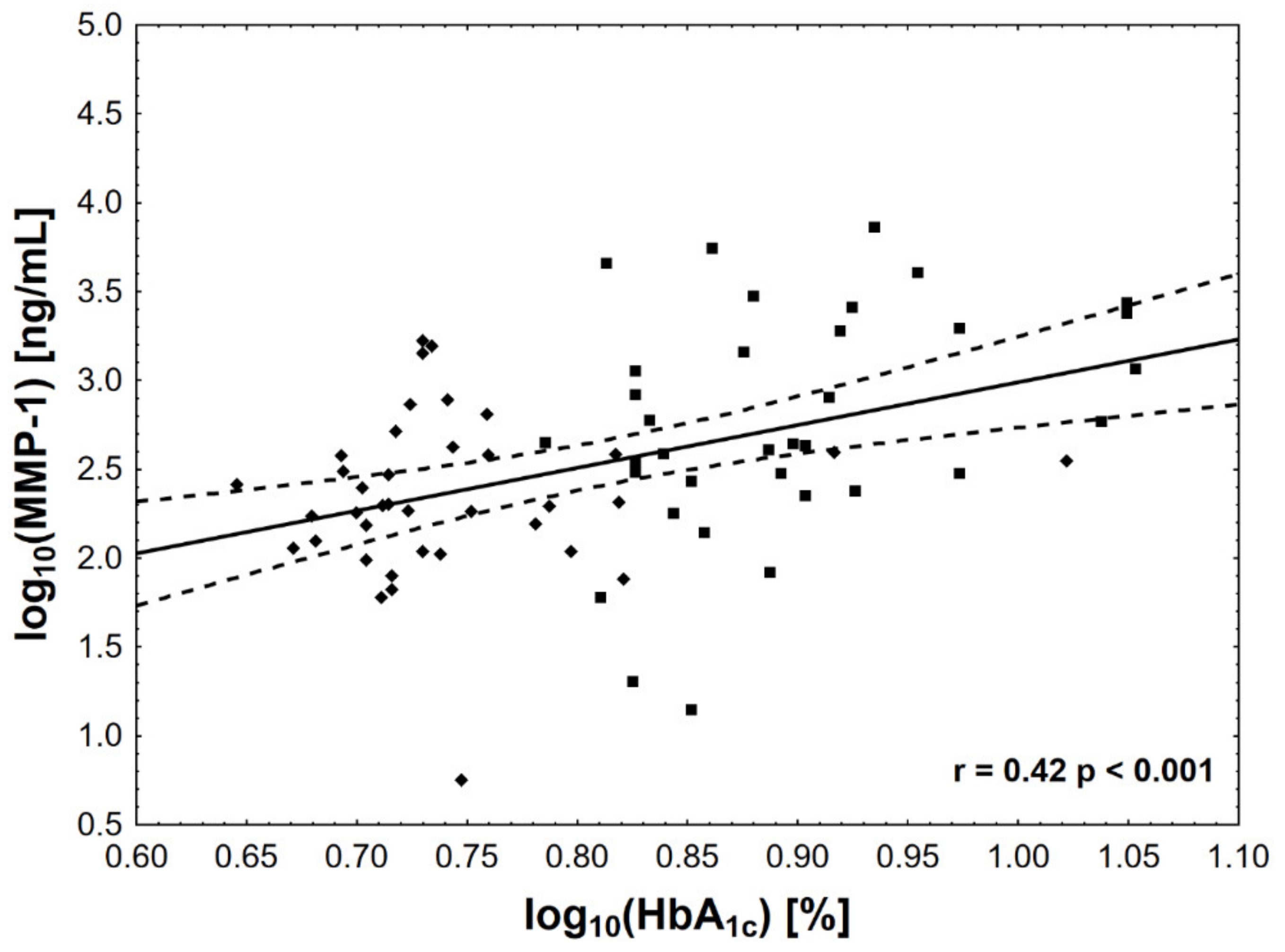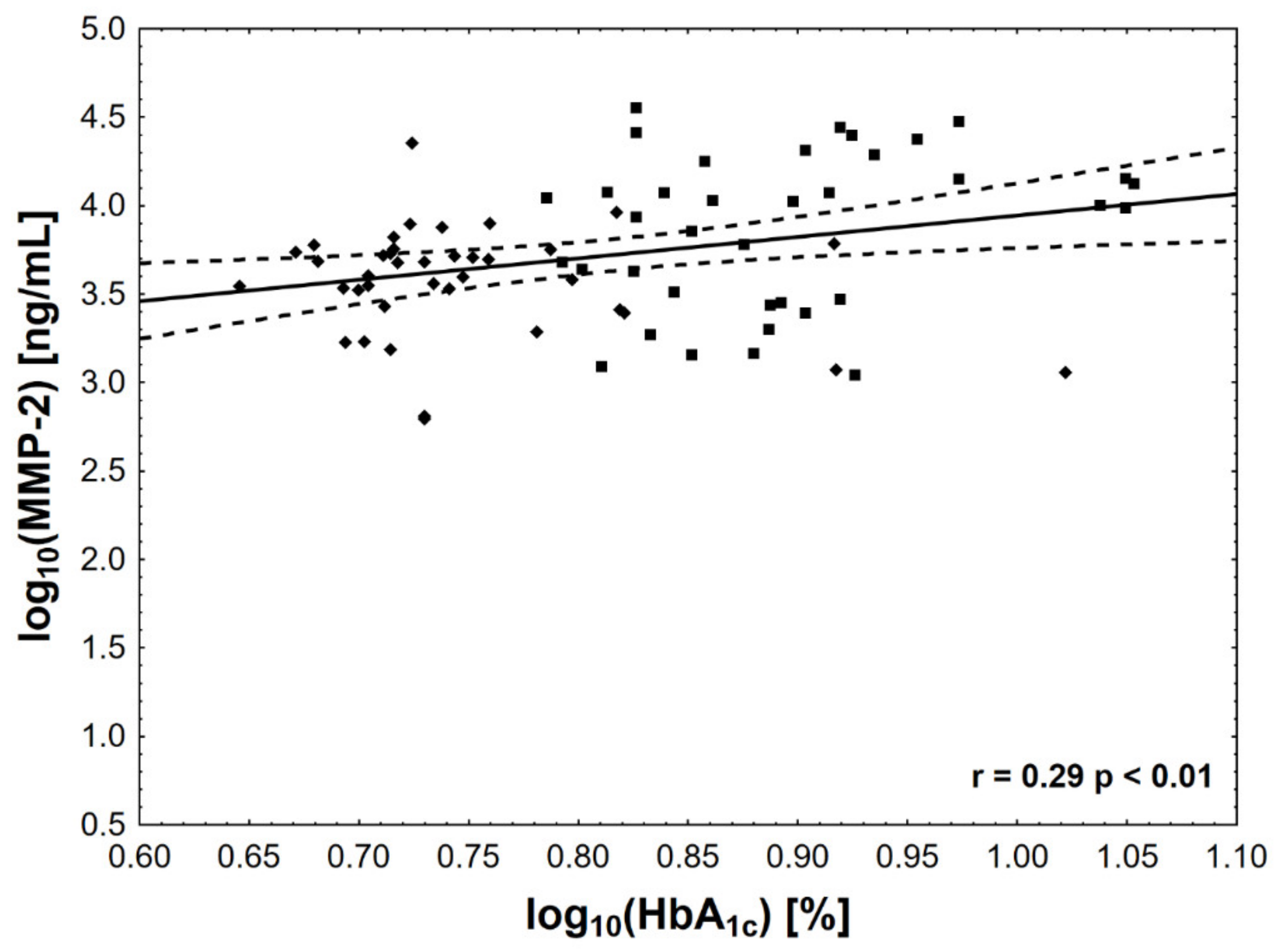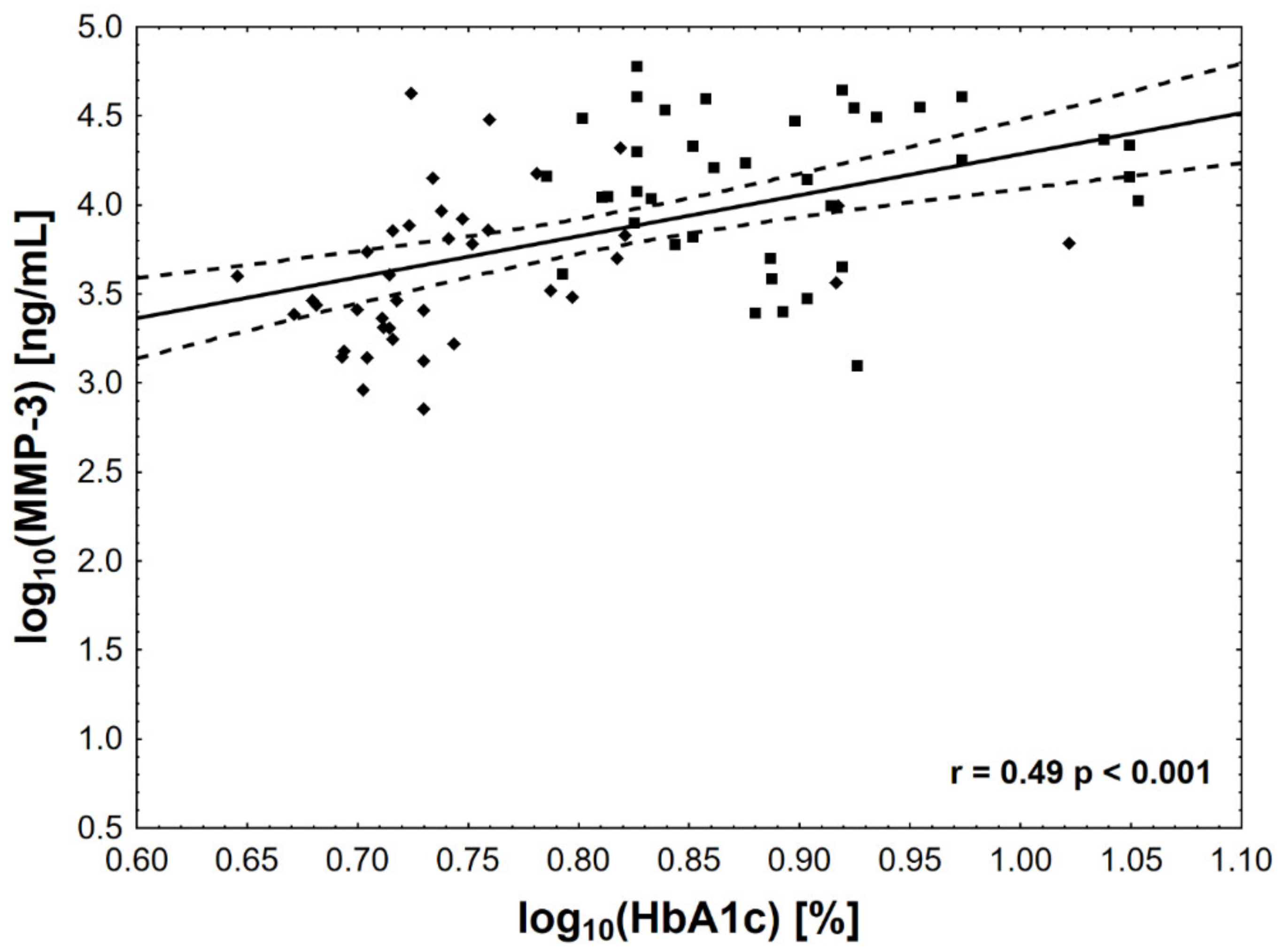Beneficial Effect of Successful Simultaneous Pancreas-Kidney Transplantation on Plasma Profile of Metalloproteinases in Type 1 Diabetes Mellitus Patients
Abstract
1. Background
2. Methods
2.1. Study Group
2.2. Carotid Artery Intima-Media Thickness (IMT) and Carotid Plaques Assessment
2.3. Carotid-Femoral Pulse Wave Velocity (PWV)
2.4. Laboratory Measurements
2.5. Data Analysis
2.6. Statistical Analysis
3. Results
3.1. Study Groups Characteristics
3.2. Structural and Functional Measures of Vascular Injury
3.3. Biomarkers of Vascular Injury
4. Discussion
Author Contributions
Funding
Institutional Review Board Statement
Informed Consent Statement
Data Availability Statement
Acknowledgments
Conflicts of Interest
References
- Lindahl, J.P.; Hartmann, A.; Horneland, R.; Holdaas, H.; Reisaeter, A.V.; Midtvedt, K.; Leivestad, T.; Oyen, O.; Jenssen, T. Improved patient survival with simultaneous pancreas and kidney transplantation in recipients with diabetic end-stage renal disease. Diabetologia 2013, 56, 1364–1371. [Google Scholar] [CrossRef] [PubMed]
- Morath, C.; Zeier, M.; Dohler, B.; Schmidt, J.; Nawroth, P.P.; Opelz, G. Metabolic control improves long-term renal allograft and patient survival in type 1 diabetes. J. Am. Soc. Nephrol. 2008, 19, 1557–1563. [Google Scholar] [CrossRef]
- Lindahl, J.P.; Hartmann, A.; Aakhus, S.; Endresen, K.; Midtvedt, K.; Holdaas, H.; Leivestad, T.; Horneland, R.; Oyen, O.; Jenssen, T. Long-term cardiovascular outcomes in type 1 diabetic patients after simultaneous pancreas and kidney transplantation compared with living donor kidney transplantation. Diabetologia 2016, 59, 844–852. [Google Scholar] [CrossRef] [PubMed]
- Luan, F.L.; Miles, C.D.; Cibrik, D.M.; Ojo, A.O. Impact of simultaneous pancreas and kidney transplantation on cardiovascular risk factors in patients with type 1 diabetes mellitus. Transplantation 2007, 84, 541–544. [Google Scholar] [CrossRef] [PubMed]
- La Rocca, E.; Fiorina, P.; Di Carlo, V.; Astorri, E.; Rossetti, C.; Lucignani, G.; Fazio, F.; Giudici, D.; Cristallo, M.; Bianchi, G.; et al. Cardiovascular outcomes after kidney-pancreas and kidney-alone transplantation. Kidney Int. 2001, 60, 1964–1971. [Google Scholar] [CrossRef][Green Version]
- Henry, R.M.; Kostense, P.J.; Spijkerman, A.M.W.; Dekker, J.M.; Nijpels, G.; Heine, R.J.; Kamp, O.; Westerhof, N.; Bouter, L.M.; Stehouwer, C.D.A. Arterial stiffness increases with deteriorating glucose tolerance status: The Hoorn Study. Circulation 2003, 107, 2089–2095. [Google Scholar] [CrossRef]
- Moe, S.M.; O’Neill, K.D.; Duan, D.; Ahmen, S.; Chen, N.X.; Leapman, S.B.; Fineberg, N.; Kopecky, K. Medial artery calcification in ESRD patients is associated with deposition of bone matrix proteins. Kidney Int. 2002, 61, 638–647. [Google Scholar] [CrossRef] [PubMed]
- Yki-Jarvinen, H.; Westerbacka, J. Insulin resistance, arterial stiffness and wave reflection. Adv. Cardiol. 2007, 44, 252–260. [Google Scholar] [PubMed]
- Chen, N.X.; Moe, S.M. Arterial calcification in diabetes. Curr. Diab. Rep. 2003, 3, 28–32. [Google Scholar] [CrossRef] [PubMed]
- Khairoun, M.; de Koning, E.J.P.; van den Berg, B.M.; Lievers, E.; de Boer, H.C.; Schaapherder, A.F.M.; Mallat, M.J.K.; Rotmans, J.I.; van der Boog, P.J.M.; van Zonneveld, A.J.; et al. Microvascular damage in type 1 diabetic patients is reversed in the first year after simultaneous pancreas-kidney transplantation. Am. J. Transplant. 2013, 13, 1272–1281. [Google Scholar] [CrossRef]
- Ziaja, J.; Kowalik, A.P.; Kolonko, A.; Kamińska, D.; Owczarek, A.J.; Kujawa-Szewieczek, A.; Kusztal, M.A.; Badura, J.; Bożek-Pająk, D.; Choręza, P.; et al. Type I diabetic patients have better endothelial function after simultaneous pancreas-kidney transplantation than after kidney transplantation with continued insulin therapy. Diabetes Vasc. Dis. Res. 2018, 15, 122–130. [Google Scholar] [CrossRef] [PubMed]
- Stadler, M.; Theuer, E.; Anderwald, C.; Hanusch-Enserer, U.; Auinger, M.; Bieglmayer, C.; Quehenberger, P.; Bischof, M.; Kastenbauer, T.; Wolzt, M.; et al. Persistent arterial stiffness and endothelial dysfunction following successful pancreas-kidney transplantation in type 1 diabetes. Diabet. Med. 2009, 26, 1010–1018. [Google Scholar] [CrossRef]
- Biesenbach, G.; Konigsrainer, A.; Gross, C.; Margreiter, R. Progression of macrovascular disease is reduced in type 1 diabetic patients after more than 5 years successful combined pancreas-kidney transplantation in comparison to kidney transplantation alone. Transplant. Int. 2005, 18, 1054–1060. [Google Scholar] [CrossRef] [PubMed]
- Sucher, R.; Rademacher, S.; Jahn, N.; Brunotte, M.; Wagner, T.; Alvanos, A.; Sucher, E.; Seehofer, D.; Scheuermann, U.; Hau, H.-M. Effects of simultaneous pancreas-kidney transplantation and kidney transplantation alone on the outcome of peripheral vascular diseases. BMC Nephrol. 2019, 20, 453. [Google Scholar] [CrossRef] [PubMed]
- Morath, C.; Zeier, M.; Dohler, B.; Schmidt, J.; Nawroth, P.P.; Schwenger, V.; Opelz, G. Transplantation of the type 1 diabetic patient: The long-term benefit of a functioning pancreas allograft. Clin. J. Am. Soc. Nephrol. 2010, 5, 549–552. [Google Scholar] [CrossRef]
- Garcia-Fernandez, N.; Jacobs-Cacha, C.; Mora-Gutierrez, J.M.; Vergara, A.; Orbe, J.; Soler, M.J. Matrix metalloproteinases in diabetic kidney disease. J. Clin. Med. 2020, 9, 472. [Google Scholar] [CrossRef] [PubMed]
- Ruddy, J.M.; Ikonomidis, J.S.; Jones, J.A. Multidimensional contribution of matrix metalloproteinases to atherosclerotic plaque vulnerability: Multiple mechanisms of inhibition to promote stability. J. Vasc. Res. 2016, 53, 1–16. [Google Scholar] [CrossRef]
- Peeters, S.A.; Engelen, L.; Buijs, J.; Chaturvedi, N.; Fuller, J.H.; Jorsal, A.; Parving, H.-H.; Tarnow, L.; Theilade, S.; Rossing, P.; et al. Circulating matrix metalloproteinases are associated with arterial stiffness in patients with type 1 diabetes: Pooled analysis of three cohort studies. Cardiovasc. Diabetol. 2017, 16, 139. [Google Scholar] [CrossRef]
- Peeters, S.A.; Engelen, L.; Buijs, J.; Jorsal, A.; Parving, H.-H.; Tarnow, L.; Rossing, P.; Schalkwijk, C.G.; Stehouwer, C.D.A. Plasma matrix metalloproteinases are associated with incident cardiovascular disease an all-cause mortality in patients with type 1 diabetes: A 12-year follow-up study. Cardiovasc. Diabetol. 2017, 16, 55. [Google Scholar] [CrossRef]
- Hecht, E.; Freise, C.; Websky, K.V.; Nasser, H.; Kretzschmar, N.; Stawowy, P.; Hocher, B.; Querfeld, U. The matrix metalloproteinases 2 and 9 initiate uraemic vascular calcifications. Nephrol. Dial. Transplant. 2016, 31, 789–797. [Google Scholar] [CrossRef]
- Lee, S.J.; Lee, I.-K.; Jeon, J.-H. Vascular calcification-new insights into its mechanism. Int. J. Mol. Sci. 2020, 21, 2685. [Google Scholar] [CrossRef]
- Kolonko, A.; Bartmańska, M.; Słabiak-Błaż, N.; Kuczera, P.; Kujawa-Szewieczek, A.; Ficek, R.; Owczarek, A.J.; Chudek, J.; Więcek, A. Arterial stiffness but not endothelial dysfunction is associated with multidrug antihypertensive therapy and nondipper blood pressure pattern in kidney transplant recipients. Medicine 2018, 97, e11870. [Google Scholar] [CrossRef] [PubMed]
- Rusińska, A.; Płudowski, P.; Walczak, M.; Borszewska-Kornacka, M.K.; Bossowski, A.; Chlebna-Sokół, D.; Czech-Kowalska, J.; Dobrzańska, A.; Franek, E.; Helwich, E.; et al. Vitamin D Supplementation Guidelines for General Population and Groups at Risk of Vitamin D Deficiency in Poland—Recommendations of the Polish Society of Pediatric Endocrinology and Diabetes and the Expert Panel With Participation of National Specialist Consultants and Representatives of Scientific Societies—2018 Update. Front. Endocrinol. 2018, 9, 246. [Google Scholar] [CrossRef]
- De Mier, V.P.-R.; Navarro Cabello, M.D.; Martinez Vaquera, S.; Lopez-Andreu, M.; Aguera Morales, M.L.; Rodriguez-Benot, A.; Rabelo, J.R.; Campos Hernandez, P.; Requena Tapia, M.J.; Aljama Garcia, P. Index high insulin resistance in pancreas-kidney transplantation contributes to poor long-term survival of the pancreas graft. Transplant. Proc. 2015, 47, 117–119. [Google Scholar] [CrossRef]
- Mora, M.; Ricart, M.J.; Casamitjana, R.; Astudillo, E.; Lopez, I.; Jimenez, A.; Fernandez-Cruz, L.; Esmatjes, E. Pancreas and kidney transplantation: Long-term endocrine function. Clin. Transplant. 2010, 24, E236–E240. [Google Scholar] [CrossRef]
- Larsen, J.L.; Colling, C.W.; Ratanasuwan, T.; Burkman, T.W.; Lynch, T.G.; Erickson, J.M.; Lyden, E.R.; Lane, J.T.; Mack-Shipman, L.R. Pancreas transplantation improves vascular disease in patients with type 1 diabetes. Diabetes Care 2004, 27, 1706–1711. [Google Scholar] [CrossRef] [PubMed]
- Dimas, G.G.; Didangelos, T.P.; Grekas, D.M. Matrix gelatinases in atherosclerosis and diabetic nephropathy: Progress and challenges. Curr. Vasc. Pharmacol. 2017, 15, 557–565. [Google Scholar] [CrossRef]
- Chung, A.W.Y.; Clarice Yang, H.H.; Sigrist, M.K.; Brin, G.; Chum, E.; Gourlay, W.A.; Levin, A. Matrix metalloproteinase-2 and -9 exacerbate arterial stiffening and angiogenesis in diabetes and chronic kidney disease. Cardiovasc. Res. 2009, 84, 494–504. [Google Scholar] [CrossRef]
- Plescovic, A.; Letonja, M.S.; Vujkovac, A.C.; Starcevic, J.N.; Caprnda, M.; Curilla, E.; Mozos, I.; Kruzliak, P.; Prosecky, R.; Petrovic, D. Matrix metalloproteinase-3 gene polymorphism (rs3025058) affects markers of atherosclerosis in type 2 diabetes mellitus. Vasa 2017, 46, 363–369. [Google Scholar] [CrossRef][Green Version]
- Peeters, S.A.; Engelen, L.; Buijs, J.; Theilade, S.; Rossing, P.; Schalkwijk, C.G.; Stehouwer, C.D.A. Associations between advanced glycation endproducts and matrix metalloproteinases and its inhibitor in individuals with type 1 diabetes. J. Diabetes Complicat. 2018, 32, 325–329. [Google Scholar] [CrossRef] [PubMed]
- Reine, T.M.; Kolseth, I.B.M.; Meen, A.J.; Lindahl, J.P.; Jenssen, T.G.; Reinholt, F.P.; Zaia, J.; Shao, C.; Hartmann, A.; Kolset, S.O. Effects of restoring normoglycemia in type 1 diabetes on inflammatory profile and renal extracellular matrix structure after simultaneous pancreas and kidney transplantation. Diabetes Res. Clin. Pract. 2015, 107, 46–53. [Google Scholar] [CrossRef] [PubMed]
- Smets, Y.F.C.; van der Pijl, J.W.; de Fijter, J.W.; Ringers, J.; Lemkes, H.H.P.J.; Hamdy, N.A.T. Low bone mass and high incidence of fractures after successful simultaneous pancreas-kidney transplantation. Nephrol. Dial. Transplant. 1998, 13, 1250–1255. [Google Scholar] [CrossRef]
- Levy, R.J.; Gundberg, C.; Scheinman, R. The identification of the vitamin k-dependent bone protein osteocalcin as one of the γ-carboxyglutamic acid containing proteins present in calcified atherosclerotic plaque and mineralized heart valves. Atherosclerosis 1983, 46, 49–56. [Google Scholar] [CrossRef]
- Evrard, S.; Delanaye, P.; Kamel, S.; Cristol, J.-P.; Cavalier, E. Vascular calcification: From pathophysiology to biomarkers. Clin. Chim. Acta 2015, 438, 401–414. [Google Scholar] [CrossRef] [PubMed]



| SPK | KTA | p | |
|---|---|---|---|
| n = 39 | n = 39 | ||
| Sex (male) (n (%)) | 17 (43.6) | 17 (43.6) | 1.00 |
| Age at the time of study (years) | 44 (40–51) | 49 (42–56) | 0.06 |
| Total duration of diabetes (years) | 26 ± 6 | 29 ± 7 | 0.10 |
| Duration of dialysis therapy prior transplant (months) | 17.0 (11.0–27.0) | 23.5 (14.0–35.0) | 0.13 |
| Follow-up after transplant (months) | 87.9 ± 36.1 | 84.5 ± 41.0 | 0.70 |
| Current immunosuppression: | |||
| Tacrolimus (n (%)) | 39 (100) | 20 (51.3) | <0.001 |
| Tacrolimus level (ng/nL) | 5.5 ± 1.3 | 5.6 ± 1.4 | 0.71 |
| Cyclosporin A (n (%)) | 0 | 19 (48.7) | <0.001 |
| Cyclosporine A (ng/mL) | - | 92.5 ± 19.9 | - |
| Antimetabolite drugs (n (%)) | 33 (84.6) | 37 (94.9) | 0.14 |
| Everolimus (n (%)) | 6 (15.4) | 1 (2.6) | <0.05 |
| Prednisolone (n (%)) | 4 (10.3) | 25 (64.1) | <0.001 |
| Prednisolone daily dose (mg/day) | 5.0 (5.0–5.0) | 5.0 (5.0–5.0) | 0.36 |
| BMI (kg/m2) | 22.6 ± 3.0 | 23.8 ± 3.6 | 0.11 |
| Active smokers (n (%)) | 6 (15.4) | 0 | <0.05 |
| HbA1c (%) | 5.37 (5.06–5.75) | 7.70 (6.70–8.43) | <0.001 |
| HbA1c (mmol/mol) | 35 (32–39) | 61 (50–69) | <0.001 |
| eGFR (mL/min/1.73 m2) | 62.9 ± 24.1 | 48.7 ± 16.4 | <0.01 |
| Total cholesterol (mmol/L) | 4.96 ± 1.06 | 5.21 ± 1.01 | 0.30 |
| LDL-cholesterol (mmol/L) | 3.18 ± 0.80 | 3.10 ± 1.04 | 0.72 |
| HDL-cholesterol (mmol/L) | 1.69 ± 0.39 | 1.50 ± 0.42 | <0.05 |
| Triglycerides (mmol/L) | 0.91 (0.50–1.25) | 1.33 (1.07–1.70) | <0.05 |
| Statins (n (%)) | 8 (20.5) | 15 (38.5) | 0.08 |
| Total calcium (mmol/L) | 2.35 ± 0.13 | 2.41 ± 0.14 | <0.05 |
| Phosphorus (mmol/L) | 1.11 ± 0.26 | 1.08 ± 0.18 | 0.38 |
| FGF23 (pg/mL) | 39.43 (18.34–70.19) | 28.84 (16.26–57.56) | 0.15 |
| α-Klotho (pg/mL) | 728 (507–905) | 864 (578–1080) | 0.51 |
| PTH (pg/mL) | 47.7 (30.1–85.1) | 67.8 (51.9–96.3) | <0.05 |
| 25-OH-D (ng/mL) | 6.68 (4.36–11.96) | 9.18 (4.65–13.41) | 0.48 |
| 25-OH-D < 10 (n (%)) | 26 (66.67) | 23 (60.53) | 0.58 |
| Alphacalcidol use (n (%)) | 18 (48.7) | 2 (5.1) | <0.001 |
| CRP (mg/L) | 1.2 (0.3–3.0) | 1.4 (0.5–5.6) | 0.26 |
| Fetuin-1 (ng/mL) | 22.8 (19.7–26.3) | 20.8 (16.4–25.1) | 0.10 |
| Osteoprotegerin (pmol/L) | 2.35 (0.93–3.59) | 1.90 (1.34–3.05) | 0.96 |
| Osteocalcin (ng/mL) | 1.31 (0.8–2.04) | 2.58 (1.34–3.74) | <0.01 |
| Osteopontin (ng/mL) | 5.8 (4.24–7.73) | 5.84 (4.18–7.89) | 0.88 |
| MMP-1 (ng/mL) | 0.20 (0.11–0.38) | 0.45 (0.27–1.97) | <0.01 |
| MMP-2 (ng/mL) | 4.04 (2.59–5.66) | 10.44 (2.99–17.88) | <0.01 |
| MMP-3 (ng/mL) | 3.67 (2.05–7.24) | 14.52 (6.72–30.95) | <0.001 |
| MMP-9 (ng/mL) | 88.4 (64.5–183.4) | 121.5 (96.6–160.6) | 0.46 |
| Carotid plaques (n (%)) | 0.01 | ||
| Absent | 19 (48.7) | 11 (29.7) | |
| Non-calcified | 6 (15.4) | 2 (5.4) | |
| Sole calcified lesion | 7 (18.0) | 8 (21.6) | |
| Few calcified lesions | 2 (5.1) | 5 (13.5) | |
| Massive calcified lesions | 5 (12.8) | 11 (29.7) | |
| IMT (mm) | 0.73 ± 0.15 | 0.77 ± 0.13 | 0.30 |
| PWV (m/s) | 12.1 ± 4.1 | 11.1 ± 3.9 | 0.30 |
| Parameter | log10(HbA1c) (%) r | Cholesterol (mmol/L) r | LDL (mmol/L) r | HDL * (mmol/L) r | log10(TG) * (mmol/L) r | CRP (mg/L) r | eGFR (mL/min/1.73 m2) r |
|---|---|---|---|---|---|---|---|
| log10(Osteoprotegerin (pmol/L)) | - | - | - | - | - | - | −0.30 p < 0.01 |
| log10(Osteocalcin) (ng/mL) | - | - | - | - | - | - | −0.37 p < 0.01 |
| Osteopontin (ng/mL) | - | - | - | - | - | - | - |
| log10(MMP-1) (ng/mL) | 0.42 p < 0.001 | - | - | 0.33 p < 0.05 | 0.36 p < 0.01 | 0.23 p = 0.05 | −0.36 p < 0.01 |
| log10(MMP-2) (ng/mL) | 0.30 p < 0.01 | - | - | - | - | - | - |
| log10(MMP-3) (ng/mL) | 0.49 p < 0.001 | - | - | - | 0.38 p < 0.01 | 0.26 p < 0.05 | −0.38 p < 0.001 |
| log10(MMP-9) (ng/mL)) | - | - | - | - | - | - |
| β SE(β) | |||||
|---|---|---|---|---|---|
| Parameter | log10(MMP-1) (ng/mL) | log10(MMP-2) (ng/mL) | log10(MMP-3) (ng/mL) | log10(Osteocalcin) (ng/mL) | log10(Osteoprotegerin) (pmol/L) |
| eGFR (10 mL/min/1.73 m2) | - | - | - | −0.060 (0.017) p < 0.001 | - |
| log10(HbA1c) (%) | 2.415 (0.614) p < 0.001 | - | 2.304 (0.473) p < 0.001 | - | - |
| log10(CRP) (mg/L) | - | - | - | - | - |
| HDL * (mmol/) | - | - | - | - | - |
| log10(TG) * (mmol/L) | - | - | - | - | - |
Publisher’s Note: MDPI stays neutral with regard to jurisdictional claims in published maps and institutional affiliations. |
© 2021 by the authors. Licensee MDPI, Basel, Switzerland. This article is an open access article distributed under the terms and conditions of the Creative Commons Attribution (CC BY) license (https://creativecommons.org/licenses/by/4.0/).
Share and Cite
Chudek, J.; Kolonko, A.; Ziaja, J.; Francuz, T.; Kamińska, D.; Owczarek, A.J.; Kuczera, P.; Kujawa-Szewieczek, A.; Kusztal, M.; Kowalik, A.P.; et al. Beneficial Effect of Successful Simultaneous Pancreas-Kidney Transplantation on Plasma Profile of Metalloproteinases in Type 1 Diabetes Mellitus Patients. J. Clin. Med. 2021, 10, 3800. https://doi.org/10.3390/jcm10173800
Chudek J, Kolonko A, Ziaja J, Francuz T, Kamińska D, Owczarek AJ, Kuczera P, Kujawa-Szewieczek A, Kusztal M, Kowalik AP, et al. Beneficial Effect of Successful Simultaneous Pancreas-Kidney Transplantation on Plasma Profile of Metalloproteinases in Type 1 Diabetes Mellitus Patients. Journal of Clinical Medicine. 2021; 10(17):3800. https://doi.org/10.3390/jcm10173800
Chicago/Turabian StyleChudek, Jerzy, Aureliusz Kolonko, Jacek Ziaja, Tomasz Francuz, Dorota Kamińska, Aleksander J. Owczarek, Piotr Kuczera, Agata Kujawa-Szewieczek, Mariusz Kusztal, Adrian P. Kowalik, and et al. 2021. "Beneficial Effect of Successful Simultaneous Pancreas-Kidney Transplantation on Plasma Profile of Metalloproteinases in Type 1 Diabetes Mellitus Patients" Journal of Clinical Medicine 10, no. 17: 3800. https://doi.org/10.3390/jcm10173800
APA StyleChudek, J., Kolonko, A., Ziaja, J., Francuz, T., Kamińska, D., Owczarek, A. J., Kuczera, P., Kujawa-Szewieczek, A., Kusztal, M., Kowalik, A. P., Bożek-Pająk, D., Kluz, J., Choręza, P., Król, R., Krajewska, M., Cierpka, L., & Więcek, A. (2021). Beneficial Effect of Successful Simultaneous Pancreas-Kidney Transplantation on Plasma Profile of Metalloproteinases in Type 1 Diabetes Mellitus Patients. Journal of Clinical Medicine, 10(17), 3800. https://doi.org/10.3390/jcm10173800








